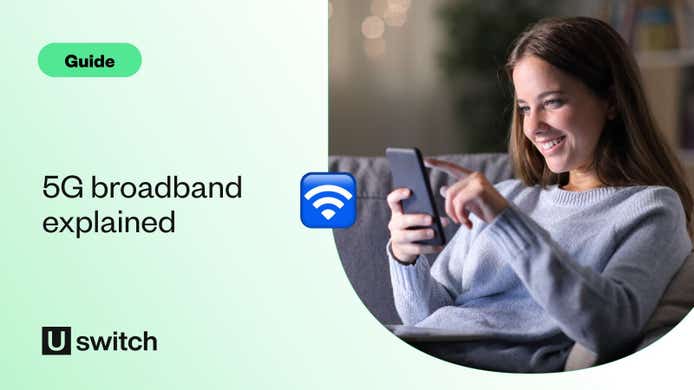MiFi devices or MiFi dongles are compact, wireless devices, usually a little smaller than a smartphone, that create a local Wi-Fi signal you can use on the go.
On the other hand, a mobile broadband router is a much larger Wi-Fi device that plugs into a mains power socket. It much more closely resembles a normal home broadband router and essentially functions like one.
The main benefit of both is that, like a router, they let multiple devices share a mobile broadband connection. However, depending on how you plan to use your mobile broadband, one may be more suitable than the other.
Read on to find out how they differ and what option would be best for you.
Our best mobile broadband deals
Check out our range of 4G and 5G mobile broadband deals.
MiFi vs mobile broadband router: how do they work?
Both MiFis and mobile broadband routers require a SIM card or eSIM to work. Just like your smartphone, the SIM allows them to connect to the Internet through a mobile internet connection on a specific network.
The main difference is how they’re built and where you can use them.
How MiFi devices work
A MiFi is a portable, battery-powered or rechargeable wireless device that taps into 4G or 5G mobile phone networks to create a mini broadband hotspot.
Its signal can be shared between multiple wireless devices within its signal range—such as smartphones, laptops, tablets, and even game consoles—and can be used anywhere with a mobile network connection.
Can data be stored on a MiFi?
Both MiFis and mobile broadband dongles have storage capabilities, and they’re typically compatible with microSD cards if you want to increase the amount of storage available.
How mobile broadband routers work
Mobile broadband routers—which can also be called 4G or 5G home broadband routers—are much more fixed. They’re much larger and powered by a mains socket rather than a battery.
This means they’re a lot less portable than a MiFi device, but they have a larger range and can handle more devices simultaneously. As a result, they could technically replace your main home broadband connection.
How fast is mobile broadband?
With the rollout of 5G networks across the UK, both devices can now access faster mobile speeds than ever before — provided they have a compatible 5G SIM card or eSIM.
If you have access to a 5G connection, both MiFi devices and mobile broadband routers could connect you to speeds faster than some fixed broadband connections.
Strong 5G connections could regularly achieve speeds of 150-200Mbps, putting it in direct competition with many ultrafast fibre packages.
However, your speed depends on your connection. It can fluctuate throughout the day based on where the device is located, what objects surround it, and how many devices share the network.
4G has a much more established mobile network across the UK right now and is capable of a more consistent connection. Its speeds usually rest around 24Mbps, which is significantly slower than 5G but still double the speed of traditional ADSL home broadband.
The benefits of mobile broadband
For more information on mobile broadband dongles, read our guide on mobile broadband dongles.
More flexible contract options than normal fixed-line broadband. There are many monthly rolling deals where you can cancel your contract with 30 days’ notice if you're unimpressed with the service.
Lower setup costs than fixed broadband. You don’t need any installation equipment to get connected, such as new lines and sockets, so that you won’t be charged any upfront fees.
If you live in an area with poor fixed broadband options, you could find a faster, more consistent broadband speed with mobile broadband.
You won't have to pay for another one if you've already got a mobile internet dongle. At around £30, this is a healthy saving. You should be aware, however, that if you want to access 5G SIM-only mobile broadband, you'll need a 5G-compatible dongle. Older dongles may only work with 4G and 3G.
Sign up for our latest broadband offers and expert advice
Get more expert insights, browse our latest exclusive offers and find money-saving deals from Uswitch.
Which providers offer MiFi and mobile broadband products?
If you don't have a dongle yet, compare mobile broadband packages and learn more about mobile broadband here.
MiFi devices
At the time of writing, EE, Vodafone, Three and O2 all offer MiFi units that are 4G capable and 3G models.
5G mobile broadband is an important alternative that could challenge standard home broadband again.
While it’s inevitable that all networks will look to provide some sort of 5G coverage, the first providers out of the gate for mobile broadband are Three, Vodafone, EE and O2.
Mobile broadband routers
Mobile broadband routers have become a lot more popular of late. Thanks to the introduction of 5G, many households with 5G coverage could replace their fixed broadband connection with a faster 5G mobile broadband one.
Vodafone and Three are leading the way with this technology, offering ultrafast mobile internet through a Huawei 5G router. Vodafone offers a product called GigaCube, and Three dubs its service ‘5G (or 4G) Home Broadband’.
You can read more about Vodafone’s offering in our GigaCube 5G mobile broadband review.
How to set up a MiFi router
One of the biggest advantages of MiFis is that they require very little setup. You simply ensure it’s charged up, insert the SIM card you were provided with and switch it on.
Within a few seconds, you should be able to find the available signal on your computer, tablet or any other Wi-Fi-enabled device. Then, it’s just a case of selecting it and inputting a password (if applicable).
There’s no software to install, and you can be online in a matter of seconds, so it’s much quicker than many home broadband installations — especially ones requiring an engineer to visit the home.
How to set up a mobile broadband router
As is the case with MiFi routers, you’ll need to insert your SIM card into the router for it to pick up any signal.
Mobile broadband routers (4G and 5G home broadband routers) must be plugged into a mains socket. So firstly, you need to find an area in your home that is best placed for a mobile internet connection. Try to find a place that’s near a window and clear from a lot of objects so the signal is as strong as it can be.
You should then be able to find it as an available Wi-Fi network in your device’s Wi-Fi settings. Once you select it there, you’ll likely have to go through a few steps online to finish setting it up.
MiFi and mobile broadband routers vs mobile internet dongles
A mobile dongle is a good option for laptop users as you can connect to the internet just by plugging your dongle into your laptop. There’s no need to charge it, and setup is still very easy.
However, you will only be able to connect one device at a time, and your dongle needs to be compatible with the device you want to use (i.e. it might need a USB connection, so you couldn’t use it to connect most tablets to the internet).
On the other hand, MiFi units and mobile broadband routers let multiple users connect to a signal simultaneously, making them handy for families and groups. If bought with a monthly rolling contract, they can also be a cost-effective option for students living in shared accommodation who don’t want to take out a long-term contract.
But as with mobile broadband dongles, MiFis and mobile broadband routers are also offered on monthly or yearly contracts and pay-as-you-go tariffs.




